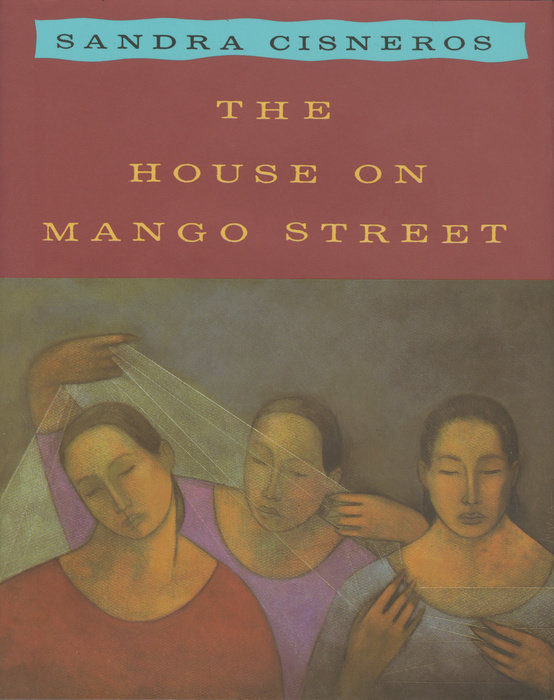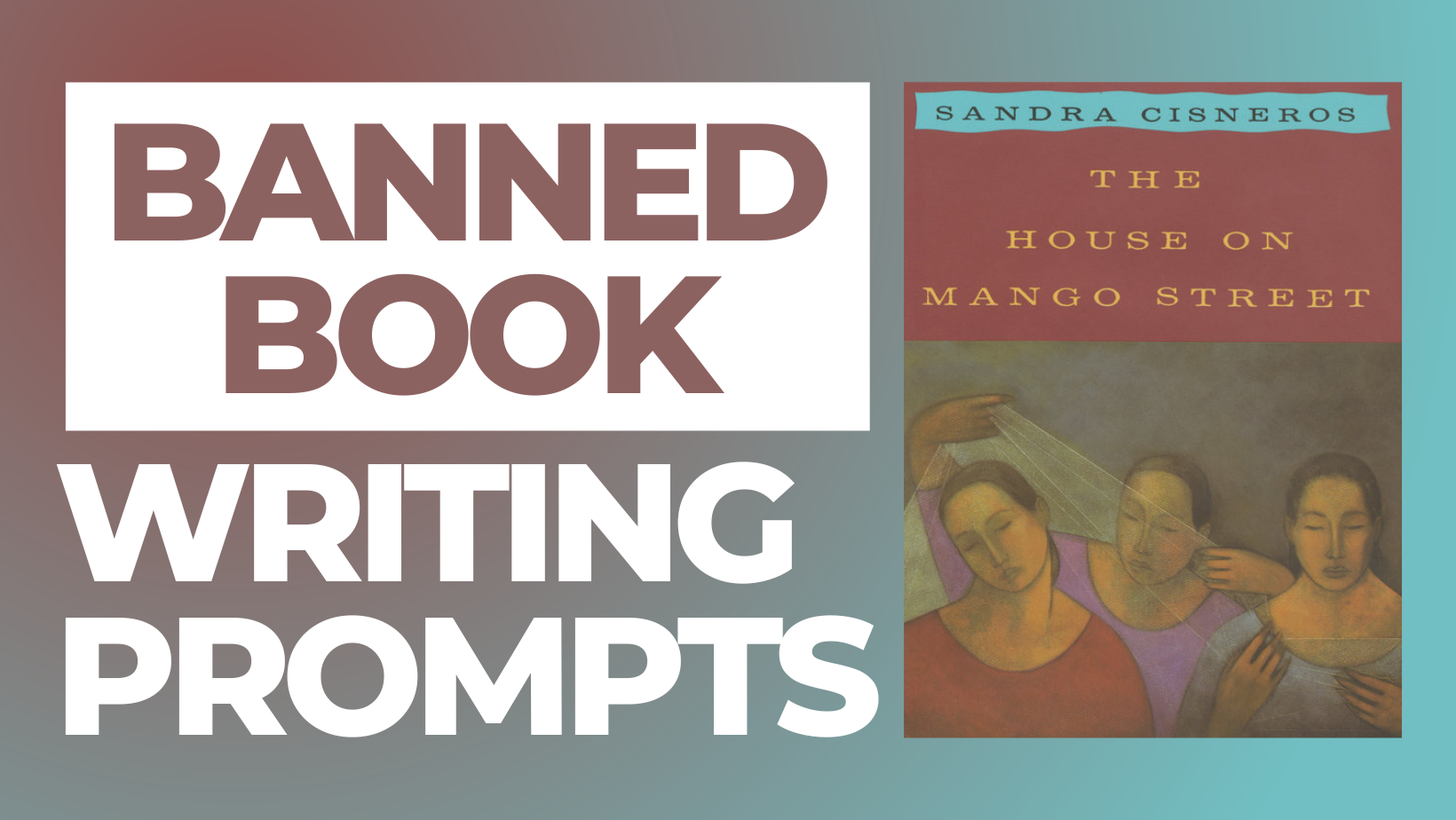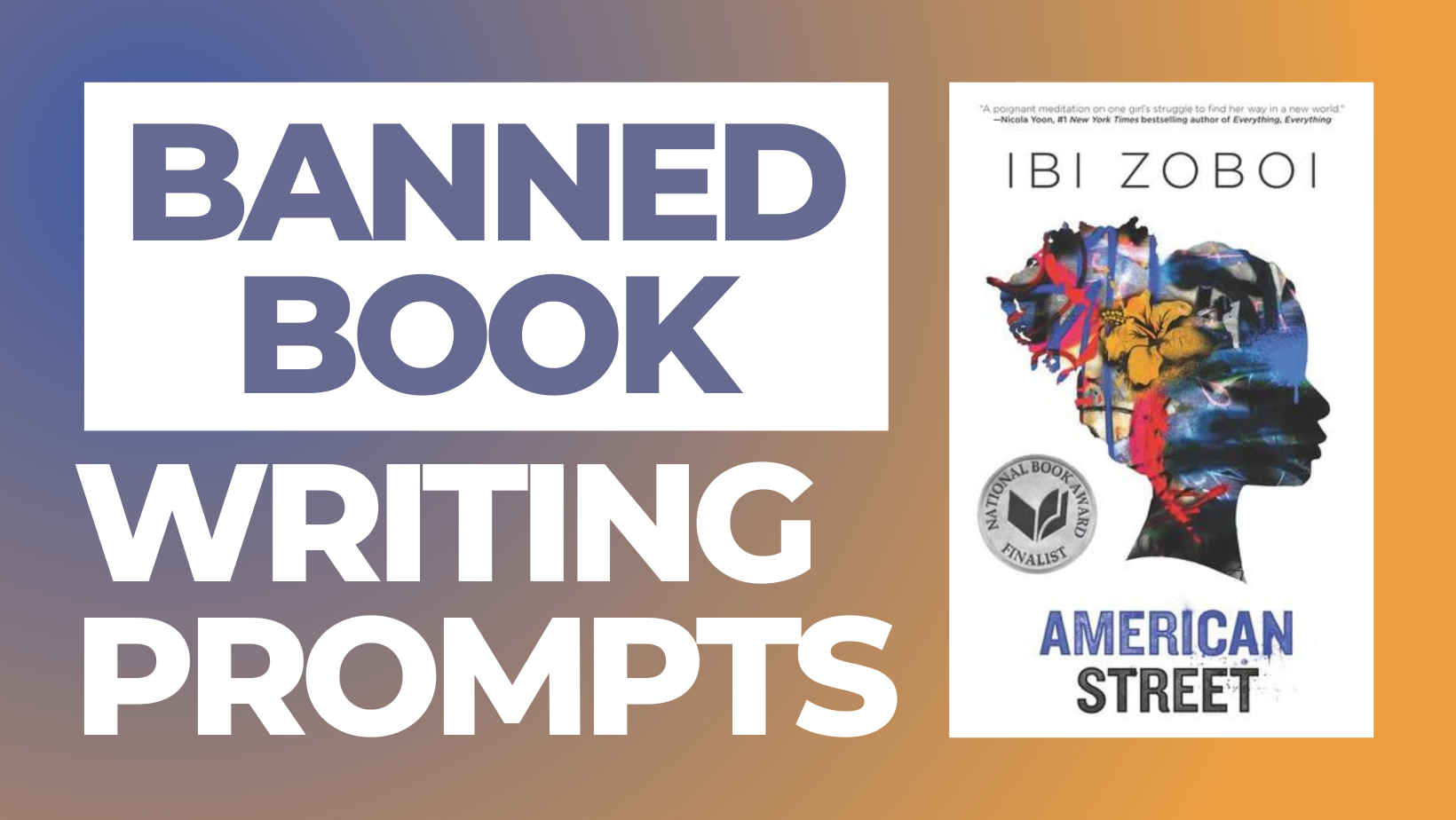In Banned Book Writing Prompts, a new series in Teachers & Writers Magazine, we aim to push back against the growing movement to censor what students can read and to show what happens when we enthusiastically embrace banned works rather than fear them. You can read an introduction to this series by Susan Karwoska here, and you can find more Banned Book Writing Prompts here.
You live there? There. I had to look to where she pointed—the third floor, the paint peeling, wooden bars Papa had nailed on the windows so we wouldn’t fall out. The way she said it made me feel like nothing. There. I lived there.
—from The House on Mango Street by Sandra Cisneros
The first time I taught The House on Mango Street it was over Zoom. I hadn’t planned it this way. I had planned a bulletin board that featured the house: “. . . small and red with tight steps and windows so small you’d think they were holding their breath,” and the characters that share its close quarters: Mama, Papa, Carlos, Kiki, Nenny, and Esperanza. There were no bulletin boards that year, no classes halted by the constant interruptions of a pencil sharpener, no interminable morning announcements, no passing periods, no overcrowded hallways, no classrooms. My students and I were surprised to find that we longed for our old lives, ached for the structure of those routines that we once mistook for a nuisance.
“Miss?” a student unmutes himself to make sure he has my attention. I had him as a rowdy ninth grader and he’s with me again in tenth. He’s the kind of kid whose personality is too big to be held by those little desks, the sort who is never in his seat, who objects to almost everything, makes you laugh, keeps you sharp. “I actually miss school,” he says.
“What do you miss about it?” I ask. “Anyone can answer,” I follow up, hoping some of these blank boxes will flicker to life, engaged by the project of collective longing. “The girls,” he says with a grin and a bunch of simulated laughter rolls into the chat. “I miss doing my makeup,” says Maya, who is shy in person but famous on Instagram. “Roasting the teachers,” says Jonny who we all agree has a real talent for that sort of thing. “I miss leaving my house,” says Mario and a stream of teenage concurrence follows in the chat: “same,” “facts,” “preach.”
Perhaps the most striking thing about teaching Mango Street that September was the fate that we shared with the novel’s adolescent narrator. Like Esperanza, we were trapped in our houses, bound by our immediate circumstances, dreaming of some dim future in which we’d be free to leave.
Most of us join class from our bedrooms, even me, who lived then with four roommates in a tight railroad apartment. None of us is sure how to navigate this strange new intimacy, how to manage this unprecedented access to each other’s daily lives. David, a student whose interruptions I am grateful for, offers observations about the room visible behind me. “Miss,” he says gently to the void, “I think you need to water that plant.” He notices when I haven’t made my bed, wants to know the cat’s name, how many roommates I have, how old I am, and will I ever have a husband, or a baby, or a house of my own?
Perhaps the most striking thing about teaching Mango Street that September was the fate that we shared with the novel’s adolescent narrator.
“Not a flat. Not an apartment in back. Not a man’s house. Not a daddy’s. A house all my own. A house quiet as snow, a space for myself to go, clean as paper before the poem.” In Mango Street’s penultimate chapter, Esperanza imagines a life beyond her family home, a future in which she is not confined by class, familial obligations, gendered expectations, or the racial inequalities that structure her Latine neighborhood in Chicago.
In Mango Street’s opening scene, a nun from school passes by the narrator’s house and sees her playing out front. “Where do you live?” she asks Esperanza, who responds by pointing up to the third-floor apartment. “You live there?” the nun asks.
“The way she said it made me feel like nothing. There. I lived there.”
Our school made the collective decision not to make the kids turn on their cameras during that year of remote learning. Though we allowed students some measure of protection over the “there” of their homes, family life had its ways of leaking into the virtual room. DJ unmutes himself to answer a question and I hear his mother calling for help unloading the groceries. Laura tells me she has to step away to scramble eggs for her siblings. Jose messages me to let me know that his mother is recovering from chemo and he is her sole caretaker. She’s reading the book too, he tells me, and she likes it.
After attending the Iowa Writers Workshop, Sandra Cisneros taught at an alternative high school in Chicago. She originally had conceived of Mango Street as a memoir, but during her time as a teacher, stories from her students’ lives seeped into the neighborhood of her past.
Cisneros says it was while she was at Iowa that she realized “loving and honest” records of her community were strikingly absent from the archives of American literature. Recent attempts to ban this book would like to reinstate that absence (see the 2010 Arizona law designed to ban Mexican American studies being taught in a Tucson School District).
Losing access to this book would be an erasure of an incandescent portrait of Chicana adolescence. Cisneros wanted to write a book for “people who don’t usually read books,” a book for people “who are busy working for a living,” one that “could be opened at any page and still make sense to the reader who doesn’t know what came before or comes after.”
There are many magical things about The House on Mango Street: the accessibility of its vignette form, its surprising use of language, its associative and dream-like structure, the way its powerful commentary on race, class, and gender remains startlingly relevant 40 years after its publication. But my favorite thing about teaching this book is its complex invitation to think about the places we come from: our houses, communities, families, neighborhoods.
Cisneros invites us to consider how we are shaped by the places we come from and what we owe to those origins. She reminds us that the way in which we understand our environment is closely related to how we understand ourselves.
“One day I will pack my bags of books and paper. One day I will say goodbye to Mango. One day I will go away” promises Esperanza in the book’s final chapter. But this departure is not an uncomplicated one. For Esperanza, the act of “going away” is marked by tenderness and ambivalence as she lays claim to the place she comes from in the very same moment that she resolves to leave it behind.
“Friends and neighbors will say, What happened to that Esperanza? Why did she march so far away? They will not know I have gone away to come back. For the ones I left behind. For the ones who cannot get out.”
Cisneros invites us to consider how we are shaped by the places we come from and what we owe to those origins. She reminds us that the way in which we understand our environment is closely related to how we understand ourselves.
In the writing prompts that follow, I invite students to write about place, identity, and community, taking passages from Mango Street as inspiration. The most generative prompt from this series is an invitation for students to write about environments that feel alive to them. I ask them to think about places they know intimately, that hold emotional resonance, that stir something in them. Places that make them feel free or trapped, that hold a sense of danger or safety––or best of all, places that inspire conflicting emotions: tenderness, contempt, uncertainty.
The work that resulted from this foray into place-based writing described houses, bus stops, corner stores, classrooms, countries. It was marked by the luminous particularity and unresolved emotions that make Cisneros’s project so powerful.
Sophia writes of “the bus stop, unpaved in all its glory / with potholes so deep one misstep and you might sink into the ground and be stuck for good.” In his poem “My Somerville, Daniel writes of our city: “It’s a place of good, and a place of shit / But what’s so bad? I can’t think of it.” In “Dear to my City,” Eliseo writes, “Anyways, all I’m trying to say is dear to my city: I hate you, thank you for making me how I am.”

Writing Prompt 1: Place
“But the house on Mango Street is not the way they told it at all. It’s small and red with tight steps in front and windows so small you’d think they were holding their breath. Bricks are crumbling in places, and the front door is so swollen you have to push hard to get in. There is no front yard, only four little elms the city planted by the curb. Out back is a small garage for the car we don’t own yet and a small yard that looks smaller between the two buildings on either side. Everybody has to share a bedroom—Mama and Papa, Carlos and Kiki, me and Nenny.”
Describe a place that makes you feel something. This place could be a house, your bedroom, a classroom, a clearing in the woods, a country. Pick a place that you know well and that inspires emotion in you––these emotions can be positive, negative, or something in between (like the ambivalence that the house on Mango Street inspires in Esperanza). Make the place come to life for your reader by using imagery, personification, and other kinds of figurative language. The reader should get a sense of how you feel about this place without you naming a single emotion––show them (through physical description) what feelings this place holds for you rather than telling them.
Writing Prompt 2: My Name
“In English my name means hope. In Spanish it means too many letters. It means sadness, it means waiting. It is like the number nine. A muddy color. It is the Mexican records my father plays on Sunday mornings when he is shaving, songs like sobbing.”
What does your name mean to you? Using Esperanza’s reflection in “My Name” as inspiration, write a short narrative (vignette) that explores any associations you have with your own name and how it reflects (or does not reflect) who you are. Consider the following questions to get started:
- What is the story behind your name? Is there any special reason you have it?
- Does your (first or last) name hold any special meaning in your family or community?
- How do you feel about your name? Do you feel it “fits” you?
- Do you have nicknames? How did you get them?
- When you say your name, how does it taste or smell? What color comes to mind?
- Do people ever mispronounce your name? Do you correct them?
- If you could change your name, what would you change it to and why?
Writing Prompt 3: Laughter
“Me and Nenny, we are more alike than you would know. Our laughter for example. Not the shy ice cream bells giggle of Rachel and Lucy’s family, but all of a sudden and surprised like a pile of dishes breaking.”
Esperanza uses a simile for laughter (like a pile of dishes breaking) to characterize her and Nenny in contrast to Rachel and Lucy. Try writing your own simile or metaphor about someone’s laugh. Think of a real person, you don’t have to say who it is, but your description of their laughter should reveal something about who they are. Try to make use of the tools Cisneros uses in her writing: simile, metaphor, imagery, and indirect characterization.
Further examples to spur your thinking:
- Simile: My best friend’s laugh sneaks out in spite of her, like a cat jumping out of a lap and padding softly into another room.
- Simile: My dad’s laugh is loud but muffled, like yelling your feelings into a pillow.
- Metaphor: The woman on the train’s loud laugh was a clamor of tambourines, rattling in every direction.

Theresa Dietrich
Theresa Dietrich is an educator who believes that personal writing is a liberatory practice. For the last five years, she has had the great joy of teaching 10th grade ELA at Somerville High School. Theresa is currently an MFA candidate at NYU, where she is working on an architecturally-inspired memoir about growing up in a hundred-year-old hotel in rural Pennsylvania among four sisters, infinite cornfields, and many rooms, rooftops, and doorways. Theresa is the 2023-24 Writers in the Public Schools Fellow at NYU. You can follow her work on Instagram @trzajane and on her website: theresajanedietrich.com.



